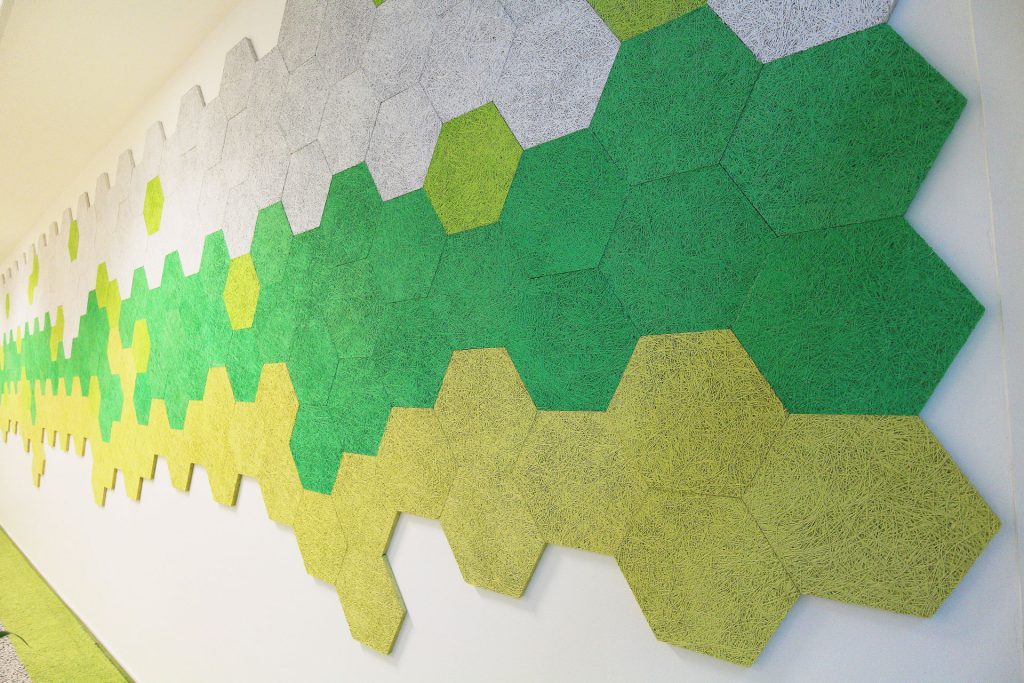
The Need for Acoustic Solutions in Co-Working Spaces
Co-working spaces are designed to foster collaboration, creativity, and flexibility. However, their open layouts can often lead to excessive noise, lack of privacy, and distractions. Managing acoustics in these spaces is essential to ensure that users can focus, collaborate, and work productively.
Wood wool panels have become a popular choice for managing acoustics in co-working spaces. These panels combine functionality, sustainability, and aesthetics, making them an excellent option for modern workspaces. In this blog, we’ll explore innovative strategies for using wood wool panels to transform the acoustic environment of co-working spaces.

Benefits of Wood Wool Panels for Co-Working Spaces
Wood wool panels offer unique advantages that make them a standout choice for acoustic management in shared work environments.
Superior Noise Absorption
The porous structure of wood wool panels allows them to absorb sound effectively, reducing reverberation and creating a quieter workspace. In co-working spaces where conversations, phone calls, and meetings occur simultaneously, these panels help maintain a balanced acoustic environment.
By reducing echoes and background noise, wood wool panels enhance the overall sound quality in the space. This makes it easier for individuals to concentrate and ensures that collaborative discussions remain clear and productive.
Sustainable and Eco-Friendly Design
Wood wool panels are made from renewable and recyclable materials, aligning with the growing demand for sustainable construction practices. Their natural composition not only makes them eco-friendly but also adds a warm and organic aesthetic to co-working spaces.
Additionally, wood wool panels contribute to certifications like LEED and WELL, helping businesses meet their sustainability goals while improving the acoustic quality of their spaces.
Versatile Applications and Aesthetic Appeal
Wood wool panels are available in various shapes, sizes, and colors, allowing for creative and versatile applications. They can be installed on walls, ceilings, or as freestanding partitions, blending seamlessly with the interior design of the workspace.
Their versatility enables co-working space designers to create visually appealing environments while optimizing sound control. Whether used as bold design elements or subtle acoustic enhancements, wood wool panels offer endless possibilities for customization.

Innovative Strategies for Acoustic Design
Wood wool panels can be used strategically to address the specific acoustic challenges of co-working spaces.
Ceiling Installations for Noise Control
Installing wood wool panels on ceilings is one of the most effective ways to reduce noise levels in co-working spaces. Suspended ceiling tiles made from wood wool absorb sound waves from above, preventing them from reflecting off hard surfaces. This approach is especially useful in large open areas with high ceilings, where noise can easily amplify.
Wall Panels for Privacy and Focus
Wood wool panels can be installed on walls to target specific areas where noise reduction is needed. For example, placing panels near meeting rooms or phone booths helps contain sound within those spaces, preventing it from disrupting the rest of the workspace. Wall panels also enhance privacy, creating quieter zones for focused work.
Tips for Optimizing Acoustic Design in Co-Working Spaces
Acoustic design is not just about installing panels; it’s about creating a holistic strategy that addresses the unique needs of the space.
- Select High-NRC Materials: Choose wood wool panels with a high Noise Reduction Coefficient (NRC) to maximize sound absorption.
- Combine With Other Elements: Enhance the impact of wood wool panels by incorporating other sound-absorbing materials like carpets, rugs, and upholstered furniture.
- Focus on Strategic Placement: Install panels near noise sources and reflective surfaces to minimize sound travel and reverberation.
- Incorporate Aesthetic Design: Use wood wool panels as decorative elements that enhance both the acoustics and the visual appeal of the space.
By combining these strategies, co-working spaces can achieve a balanced acoustic environment that promotes productivity, collaboration, and comfort.

Transforming Co-Working Spaces with Wood Wool Panels
Wood wool panels offer a versatile and effective solution for the acoustic challenges of co-working spaces. Their ability to absorb noise, reduce reverberation, and enhance privacy makes them an essential element of modern workspace design.
Beyond their acoustic benefits, wood wool panels stand out for their sustainability and aesthetic appeal, helping businesses create environmentally responsible and visually engaging spaces. Whether installed on walls, ceilings, or as freestanding partitions, these panels provide the flexibility needed to meet the diverse needs of co-working environments.
By adopting innovative strategies and focusing on effective placement, co-working spaces can transform into productive, comfortable, and collaborative environments that cater to the demands of modern work culture.
References
- Wood Wool Panel Applications – Learn more about the versatile uses of wood wool panels in acoustic design: Wood Wool Acoustic Solutions
- Acoustic Challenges in Co-Working Spaces – Explore strategies for managing noise in shared workspaces: Acoustic Design for Co-Working Spaces
- Sustainable Acoustic Panels – Discover the eco-friendly benefits of wood wool panels: Sustainable Acoustic Materials
- NRC Ratings for Acoustic Panels – Understand the role of NRC ratings in selecting sound-absorbing materials: NRC Ratings Explained
- LEED Certification for Workspaces – Learn how wood wool panels contribute to green building certifications: LEED and Acoustic Panels
Share